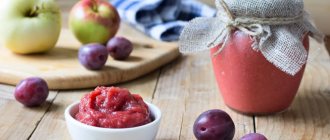Carrots are a source of large amounts of vitamins and microelements. Children need it for full development. And although this is far from the first product in a baby’s new diet, one day the question arises of how to introduce carrots into complementary foods. Mothers wonder when to give and how to prepare carrot puree. These questions should be considered in advance so that further questions do not arise.
Carrots - benefits and harm
Carrots are rich in vitamins B, K, C, E, A, PP. In particular, it contains a lot of beta-carotene, that is, vitamin A. One small root vegetable contains a daily dose of this vitamin. It helps in the prevention and treatment of vision diseases, and in good condition of the skin. Vitamin C strengthens the immune system.
Carrots help improve digestion, the functioning of the cardiovascular system, are good for the liver and kidneys, act as an antioxidant, have a wound-healing effect, promote proper development and growth, strengthen bones and teeth. It improves the composition of the blood, removing waste and toxins from it. Helps remove vitamin deficiency. In addition, it helps to cope with such troubles as worms and other parasites.
And yet, carrots have contraindications. Due to its bright color, it is quite allergenic. In addition, it is prohibited for certain gastrointestinal diseases. Rather than a prohibition, it is a warning that you should not eat excessive amounts of carrots. Otherwise, there may be a risk of yellow spots on the body (especially on the palms and soles), drowsiness, lethargy, as well as diarrhea and vomiting.
Useful properties of carrots
Carrots contain a large amount of vitamins, micro- and macroelements. It is very beneficial for the health of adults and children.
To understand what determines the beneficial properties of carrots for children, let’s look at what it consists of at the molecular level:
Chemical composition (per 100 g of carrots):
- Water – 88 g
- – 7 %
- Proteins – 1.3%
- Fats – 0.3%
- Vitamins:
- (beta-carotene) – 9 mg
- (ascorbic acid) – 5 mg
- Vitamin PP – 1 mg
- (tocopherol) – 0.6 mg
- Vitamin B2 (riboflavin) – 0.07 mg
- Vitamin B1 (thiamine) – 0.06 mg
- – 8 mcg
Macro- and microelements:
- Potassium – 270 mg
- Sodium – 156 mg
- Phosphorus – 94 mg
- Calcium – 83 mg
- Copper – 80 mcg
- Magnesium – 38 mg
- Iron – 7.4 mg
- Iodine – 5 mcg
And also chromium, zinc, cobalt, fluorine, manganese, nickel, molybdenum.
The calorie content of carrots is about 35 kcal.
It is thanks to its rich composition that carrots are useful for everyone. Since ancient times it has been used primarily as a medicinal plant and only then as a vegetable. First of all, carrots are known for containing carotene - provitamin A. Provitamin is a substance that, after certain chemical reactions in the body, turns into vitamin A. And in translation from Latin carota means “carrot”. It is rightfully considered the main source of plant vitamin A (carotene). In the body, it promotes the growth and strengthening of bones, healthy skin, teeth and gums, hair; plays an important role in the functioning of the immune system, especially increases resistance; participates in the synthesis and regulation of hormones. Retinol is a component of the main visual pigment rhodopsin. With its help, light is converted into brain signals that allow a person to perceive images. Retinol, being an antioxidant, provides protection for the body, since it acts as a structural component of cell membranes.
It should be noted that vitamin A is fat-soluble, so carrots must be consumed with a small amount of vegetable oil or sour cream to convert carotene into retinol.
Carrot juice is also very useful. Our ancestors used it in the treatment of purulent wounds, burns, and frostbite.
How to introduce carrots into complementary foods
There is no need to rush into introducing this root vegetable into your diet. No matter how useful it is, it is very difficult for the body to digest. Until 8-9 months, all carrot puree eaten for a baby will come out almost unchanged. Therefore, carrots are introduced into the diet as almost the last vegetable.
It is worth giving it when the main products have already been introduced, and the first complementary foods are far behind. It is necessary to add gradually, starting with one dessert spoon, doubling the portion and bringing it to 100-150 ml.
You can introduce it in two ways: simply gradually as a homogeneous puree or by mixing it into what has already been introduced. Both options are quite suitable, but the second one will be softer. It is also necessary to monitor the reaction, digestion and stool of the baby. If traces of carrots are visible in the stool, this is normal. The main thing is that there are no rashes, redness or, on the contrary, yellowing of the skin. If the baby is calm, then you can continue to offer carrots. Well, a rule that every mother should know: a new product must be introduced into the diet in the first half of the day. Thanks to it, many negative consequences can be avoided.
Only the mother of the infant decides how to administer it correctly. It is easier for her to understand what he needs.
When can you give your baby carrots?
Complementary feeding starts with vegetable puree. At first, the baby’s menu includes zucchini, broccoli, and potatoes. When the little one has already tried these vegetables, the time comes for more allergic foods, and it’s the turn of carrots. It appears in the baby’s diet at approximately seven months of age for children on guard, and two months earlier for children on willow. Do not forget that the first vegetable purees should be monocomponent and have a homogeneous consistency. The first juice from this vegetable is administered a month or two after the puree. It is not recommended to give carrots in their raw form until they reach one year of age.
And don’t forget that the first portions of puree are half a teaspoon. And only if after two days there are no changes in the baby’s health, feel free to increase the portion. A month after the start of the introduction, the daily norm is 40 grams of carrot puree, but do not forget that you can already add this vegetable to soups. A one-year-old child can eat up to 200 grams of carrot puree.
I introduced this puree to my son after pumpkin puree, he was seven and a half months old. This product did not cause any allergies, however, I did not notice any strong interest in the child. Still, he preferred pumpkin puree, which was also quite enriched with beta-carotenes.
In what form to introduce carrots
Carrots for the first feeding should be carefully heat-treated and chopped. It can be boiled or steamed.
Before preparing puree for baby food, the orange vegetable must be thoroughly washed and peeled. Cut into small pieces. Throw the root vegetable into boiling water and cook for 30-40 minutes until soft. Then puree with a blender or rub through a sieve. How long to cook carrots depends on how long ago they were harvested. The older the vegetable, the longer it takes to cook.
Carrot puree for babies can be made by steaming, baking or cooking it in a slow cooker. Steaming carrots is most beneficial, as it preserves a large amount of vitamins.
Later, when the child can eat food in pieces, it can be added to various vegetable, meat, fish dishes, as well as soups and lean porridges.
Carrot puree - recipe
For carrot puree, we need 100 grams of selected carrots, 25 ml of milk and about 3 grams of vegetable oil.
We first wash the main ingredient of the recipe and peel it with a brush. Cut into strips or grate on a coarse grater, then pour boiling water so that the water lightly covers it. Place on low heat and simmer until done. Once boiled, discard it in a colander and grind to a puree using a blender or rubbing through a fine sieve. Next, add warm milk, a little salt to the carrot puree for babies and bring it to a boil. The final stage involves adding vegetable oil and thoroughly mixing. Once this healthy and tasty dish for babies is ready, let it cool slightly.
As you can see, the process of preparing carrot puree is quite simple, but the main thing you should pay attention to is the quality of the main component of the dish - carrots. Of course, every mother can buy ready-made carrot puree in the store, but by preparing it yourself, you will be sure that your child will receive a nutritious and truly healthy product, prepared with love.
“The beauty is sitting in prison, and her braid is on the street.” There is hardly a person in Russia who does not know the answer to this riddle. And it’s even harder to imagine a person who has never eaten carrots. Since childhood, we have known about the benefits of vegetables, which contain a huge amount of vitamins; we were told: if you eat a lot of it, you will grow faster and see better. So what is unique about this miracle carrot?
Carrots are a biennial plant from the Apiaceae family. In our diet, we use cultivated, or seeded, subspecies of wild carrots, which were originally grown in the Mediterranean. In Ancient Greece, more than 4 thousand years ago, they were familiar with the healing properties of carrots; they were considered a sacred plant. In the 17th century, carrots were still considered a delicacy in different countries. There is a legend that the gnomes exchanged the red-haired beauty for gold bars, because they liked her so much.
Carrot dishes
For children who tolerate cow's milk well, you can prepare puree soup. To do this, carrots must be washed, peeled and cut into pieces. Pour milk into a small saucepan and bring it to a boil. Add carrots there and cook until soft. Then beat with a blender.
Many kids will love sweet carrot pancakes. For them you will need: carrots, apple, dried fruits, milk, egg, rolled oats, butter.
- Pour boiling water over the dried fruits and let them soak.
- Peel and grate the apple.
- Grate the carrots on a fine grater and put them in a saucepan to simmer.
- Chop the dried fruits and send them to simmer together with the apple in another pan.
- Grind the Hercules in a coffee grinder.
- When everything is ready, mix the root vegetable with milk, egg and rolled oats.
- The mass should be quite plastic. Form it into thick pancakes and put a sweet fruit filling in the middle. Seal them and form pancakes again.
- Fry in butter on both sides.
- Cooked pancakes are best served with sour cream.
Another sweet dish would be cottage cheese and carrot casserole. To do this, you need to grate the carrots on a fine grater and simmer until half cooked. Rub the cottage cheese through a sieve and mix with the egg, butter, sour cream and small cereals (semolina or crushed oatmeal). Then add the prepared carrots and grated apple. How to cook: place the mixture in a deep baking tray or frying pan and bake for 30-40 minutes.
Carrot juice is essential for complementary feeding. Although most doctors are against juices in general, some types are allowed. Including from this vegetable. To prepare it you need a juicer. Then it should be strained so that no pieces of pulp remain. For a more pleasant taste, you can add a little sugar. Despite the fact that juice is very healthy, its quantity is limited - no more than 0.5 glasses per day.
Meat and carrot cutlets will also be very useful. Grind the chicken fillet in a meat grinder. Boil the carrots until half cooked and grate them on a fine grater. Mix the minced meat with the root vegetable, add the egg and soaked oatmeal. Form cutlets and steam.
Most children love to chew on this sweet orange vegetable. But even here you should limit the number of carrots you eat. It is worth doing this because it is difficult to digest in the body. And an excess of nutrients is not good - hypervitaminosis is possible. But the first complementary food should only be boiled. You can start feeding it raw closer to the age of one year.
| calories, kcal/100 g | proteins, g | fats, g | carbohydrates, g | |
| raw | 32 | 1,3 | 0,1 | 6,9 |
| stewed | 30 | 1,0 | 0,2 | 6,3 |
| boiled | 25 | 0,8 | 0,3 | 5,8 |
Rules for introducing juice
It is recommended to introduce carrot juice no earlier than eight months of age. In this case, you need to follow the following tips:
- Juice should be given without pulp.
- The first time, be sure to dilute it with water by half. This applies mainly to homemade juices.
- At first, the juice should be purely carrot juice. After adaptation, carrots can be combined with already familiar other fruits and vegetables.
- Start administering with 5 ml, in the absence of allergies, gradually increase the rate and bring it to 100 ml by the age of one year.
- It is advisable to give the child juice after he has eaten.
So you found out what a healthy product carrot puree and juice can be. Dear parents, try to follow all the rules and regulations regarding the selection, preparation and consumption of certain vegetables. Do not forget that representatives of this group of products are rich not only in vitamins and minerals, but also in pectin and fiber, which are so necessary for the proper digestion of a little gourmet.
It's no secret that carrots are rich in vital nutrients, including carotene - the main source of provitamin A. In the baby food system, this root vegetable is used not only in the form of juice, various cutlets, casseroles and main courses, but also the familiar lots of carrot puree. In this material we suggest looking at how to prepare carrot puree, the recipe for which is quite simple. But let us immediately note: given the possibility of an allergy to this product, carrot puree for infants should be taken with caution.
So, we bring to your attention a recipe that describes how to prepare carrot puree for children. As a rule, a favorite and healthy crunchy delicacy is introduced into the diet of children in the second half of life in the form of carrot puree, and only after some time it can be consumed in another capacity.
The recipe for this carrot delicacy assumes the presence of fresh root vegetables without the content of fertilizers and herbicides harmful to the child’s body. You can grow such a product yourself in a suburban area or buy it on the market. If the purchased root vegetable does not inspire confidence in you, it is recommended to soak it in cold water for two hours.
Subscribe to Baby Feeding on YouTube!
How to choose carrots in the store
Of course, if mom doesn’t want to bother, then the easiest way is to buy ready-made puree in a jar. However, it is still worth checking the expiration date and integrity of the packaging.
But if mommy wants to cook herself or the baby refuses jarred puree, then you need to know which vegetable will bring the greatest benefit.
- No matter how attractive already washed carrots are, they should not be taken, since they are treated with special chemical compounds. It's better to be dirty, but without chemicals.
- The root vegetables themselves should be strong, elastic, and rich orange or yellow in color. If the fruits are soft and limp, this means that they have been on the counter for too long and, therefore, are not suitable for baby food.
- If you buy young carrots, the tops should be green, without yellowing or other deviations in color.
- If you buy unwashed carrots and then peel and cut them at home, you may encounter such a nuisance as small black marks. These are traces of a wireworm. These vegetables should not be given to your baby.
- There should be no cracks or any other damage on the surface of the root crop. It itself should be smooth, in the shape of a cone.
Carrots are a very valuable product, as they are a storehouse of provitamin A, which, in turn, is necessary for vision. It also contains many other beneficial substances. At what age it should be introduced into complementary foods, the mother herself will decide, but there is no need to rush, since early introduction will not bring any benefit, but will only do harm. But it most often becomes the most favorite vegetable, because it is sweet and you can crunch it cheerfully.
Recipe 3: “Vegetarian” carrot puree
This dish will appeal to anyone who leads a healthy lifestyle or adheres to a vegetarian diet. The dish does not contain animal fats, has low energy value, and is rich in slow-acting healthy carbohydrates.
Required ingredients:
- Broccoli 200 grams
- Potatoes 1 piece
- Carrots 2 pieces
Cooking method:
- Wash the broccoli and separate it into florets. Let it cook in a saucepan filled with salted water for ten minutes. When the cabbage is ready, remove it.
- Wash the potatoes, remove the skins.
- Wash the carrots and cook together with the potatoes in a separate container. After 15 minutes, remove the potatoes, after another fifteen you can remove the carrots from the pan.
- Place the vegetables in a blender bowl and puree them, adding liquid from the pan where the cabbage was cooked.
You can squeeze the garlic into the finished puree through a press and garnish with chopped herbs.
Rules for choosing store-bought puree
Stores sell a lot of ready-made purees in jars. There are some rules on how to select a product:
- look at the expiration date;
- how tightly the packaging is sealed;
- what is included.
Semper brand puree
These jars should be stored either in the refrigerator or in a dark closet. It should be understood that the baby will not eat the whole jar. It is recommended not to store such a product after opening, but on the labels you can often find information that the puree can be stored in the refrigerator for several days. Before use, the contents are heated in a water bath to 36-37 degrees.
Cutlets in a slow cooker
By preparing carrot cutlets in a slow cooker, mom will simplify her task and retain maximum benefits from root vegetables. The dish will be appetizing and light, suitable for babies up to one year old. For it you will need 1 carrot, half a raw egg, 2 tablespoons of semolina, 120 ml. milk. The cutlets are prepared as follows:
- fresh root vegetables are grated on a fine plastic grater, placed in a multicooker bowl,
- completely fill with milk or carrot broth, turn on the “Stew” mode for 15 minutes,
- add semolina, stir until thickened,
- Place the minced meat in a deep bowl, add half an egg, a spoonful of strawberry jam (optional), mix thoroughly,
- form cutlets, place on a bowl greased with vegetable oil for steaming,
- cook in the “Steam” mode for 15 minutes,
- served with milk or sour cream.
Note to mom
The choice of the optimal option for vegetable complementary feeding depends on the age and characteristics of the baby’s body. It should not be delayed if the baby has low hemoglobin, colic and constipation. Delicate monopures and juices can be seasoned with salt, pumpkin and apple puree can be added. Gradually, the list of children's dishes based on root vegetables will expand. A one and a half year old baby will love sweet cookies with carrots and oatmeal, and fragrant casseroles.
https://www.youtube.com/watch?v=NMlJ9OzLgPk
Carrots retain their beneficial properties no matter how they are cooked. It is important for the mother to understand what the baby and his tummy like most - this will help her regularly pamper the baby with light dishes and drinks.
Possible problems
During the first feeding, the mother should carefully monitor the child’s well-being. A negative reaction manifests itself in:
- lethargy;
- drowsiness;
- nausea and vomiting after feeding;
- if root vegetables are consumed too often, jaundice may appear (the skin and whites of the eyes will turn yellow);
- in rare cases, urticaria and even swelling of the laryngeal mucosa occur.
Baby eats carrot puree
Symptoms disappear as soon as the product is eliminated from the diet.
Signs of allergies
An allergic reaction to root vegetables may appear immediately, or maybe after a few hours.
Signs:
- The baby becomes slow and apathetic;
- Pain in the abdomen is disturbing, diarrhea, nausea or vomiting may begin;
- The skin becomes covered with spots, itches, rashes, and irritations greatly bother the child.
Manifestation of allergies
In winter, preparing carrot puree for babies is doubly healthy. During the period of infections and viral diseases, it will strengthen the immune defense, add health and invigorate on harsh cold evenings.
Secrets of selection and preparation
Photo: Depositphotos.com. Author: AntonioGravante.
The choice of carrots for preparing baby food must be approached with special responsibility. Adhere to the following rules:
- Look for good, tight specimens with a natural shape (no bends).
- The peel should be smooth and bright orange in color.
- Want to choose carrots that last a long time? Look for root vegetables with green leaves - they stay fresh longer. But when you get home, be sure to cut off the green part to avoid moisture loss.
- A blackened top indicates that the vegetable is stale. It is better to refuse such a purchase.
- The most tender and sweetest are medium-sized young carrots (weighing approximately 150 g), tapering at the end. Thicker specimens may be too tough - they will be more difficult for the housewife to handle during cooking, and they also contain more nitrates.
Symptoms of a negative reaction to carrots
German pediatricians advise young mothers to start their first vegetable complementary foods with carrots. They believe that the benefits of the root vegetable are much greater than the risk of negative reactions. Before following this and other advice, parents should rule out the risk of inherited food allergies and consult their doctor.
During the first feedings, it is important for the mother to closely monitor the well-being of the little eater. A negative reaction to the root vegetable may be indicated by lethargy, drowsiness, nausea and vomiting after feeding. With frequent consumption of the vegetable, the skin and whites of the eyes may acquire a yellowish tint. In rare cases, urticaria and even swelling of the laryngeal mucosa are observed. After eliminating the root vegetable from the diet, everything returns to normal.
Council for selection
When choosing carrots for your baby, pay attention to:
- so that the root crop is fresh - not wrinkled, and of high quality - without mold, black spots, rot;
- Do not be tempted by too large vegetables; it is possible that they were “fed” with nitrates. Fruits weighing 100-150 g are exactly what you need;
- If you buy root vegetables at the market, ask the seller for documentation confirming the environmental safety of the product.
At home, you can determine the presence or absence of foreign odors in the root crop. You need to eat a small piece of a fresh vegetable and make sure of its quality taste, and then you can safely cook it for your baby.
Teach your baby to eat properly and healthy from a very early age. Carrots must be in a child’s diet so that the baby can fully develop, receiving everything he needs for this.
Read also: Allergy to carrots in infants
Click Share and make your friends happy!
Like any new product on your little one's table, carrots can cause some trouble.
Pieces of this or that product in the baby’s feces indicate that the baby’s body does not digest this product.
If this case is isolated, nothing needs to be done, you just need to more carefully monitor the child’s well-being. If this phenomenon recurs, and the child suffers from bloating, diarrhea, nausea, it is necessary to seek help from a gastroenterologist. And after the tests, the doctor will prescribe treatment: diet, probiotics, preparations with bifidobacteria and enzyme preparations.
Delicious and healthy juice
Every mother should know how to prepare carrot juice for her baby, because preparing it as complementary food involves several important points.
- At the preparatory stage, you need to peel, wash and leave the vegetable in water for a couple of hours to soak it. Only after this the carrots will be ready for subsequent actions.
- Grate the root vegetable and squeeze out all the juice from the resulting pulp. The easiest way to do this is with several layers of gauze.
- But such a concentrated juice may seem too heavy to the baby’s stomach. Therefore, dilute it with boiled water in a 1:1 ratio. When the child grows up a little, you can add apple juice to the diluted carrot juice: it will turn out even tastier and healthier.
To avoid hypervitaminosis, carrot juice can be given to a child no more than 2 times a week.











